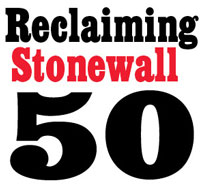 The 50th anniversary of Stonewall provides us with an opportunity to celebrate our survival and the remarkable strides we’ve made—politically, legally, culturally—during the last half century. We have come a long way.
The 50th anniversary of Stonewall provides us with an opportunity to celebrate our survival and the remarkable strides we’ve made—politically, legally, culturally—during the last half century. We have come a long way.
But this is also a moment to take stock of the complicated and contested dynamics within the LGBTQ community. Marginalized people understandably respond to oppression and exclusion by creating alternative spaces where we can define our own “normal.” In doing so, we also establish our own boundaries and borders, our own distinctions between “us” and “them,” that sometimes lead to new kinds of oppression and exclusion. This is the case within the LGBTQ community, which has often been overly invested in a “normalcy narrative” of civil rights: “We should be accepted because we’re like you, just gay.”
Some of us are anything but normal. Those who are more difficult for mainstream culture to understand—especially transgender and bisexual people—are still often excluded because we complicate this convenient narrative and challenge simple binaries. More often than not, we are perceived as liabilities to the larger community and movement—and treated that way.
As a bisexual woman, I have lived this reality. I have identified as bisexual for 42 years. In 1982, six years after coming out to myself as bisexual, l finally gathered the strength to live openly. But when I showed up in “lesbian and gay” spaces, I discovered that bisexual people were largely unwelcome. Our presence was often challenged—sometimes subtly, sometimes overtly. We were rejected from gay spaces and accused of trespassing in lesbian spaces. We were told that bisexual women are sexual “tourists” who exploit the lesbian community and dilute its “purity.” Some of my bisexual friends found it too uncomfortable, so they left. I was one of the few who persisted and insisted on my belonging.
The fact is that our community has always included people who loved more than one gender. In 1970, out and proud bisexual activist Brenda Howard organized a rally and march in New York to commemorate the anniversary of the Stonewall riots, the first of the annual LGBTQ marches and celebrations that now take place in cities around the world. Some of the prominent cultural figures claimed by the lesbian movement, writers Kate Millett and June Jordan among them, loved more than one gender. But they knew emphasizing this publicly would result in them losing their standing in the lesbian community. So many others also remained silent. I don’t fault them for this, but their silence has facilitated our erasure.
Popular
"swipe left below to view more authors"Swipe →With some notable exceptions, our histories have been written by white, cisgender lesbian or gay people. I rarely see anything that reflects the full, diverse LGBTQ history I have witnessed and am living. Bisexuality, if mentioned at all, is rarely given more than a few paragraphs. For this reason, among so many others,I celebrate the recent recognition of Sylvia Rivera and Marsha P. Johnson, both of whom—in addition to being women of color, transgender, and poor—were also bisexual. May we remember our trailblazers in all of their complexities.
Over the past three decades, I have spoken in 48 US states and 15 countries. I have witnessed a vast multitude of experiences, communities, and lived realities. In some places, many LGBTQ people are woven fully into the cultural fabric of their communities and being “out” is not a big deal. In other places, this remains unimaginable. Several years ago, when I spoke in Laramie, Wyoming, a student told me with tears in his eyes: “You are a visitor from a future that I hope to live in someday.” When I heard this, I cried, too.
So many of us still struggle, to varying degrees, with racism, transphobia, biphobia, and other forms of oppression. Being authentic is still an act of real courage. The opportunity to meet on-the-ground activists, living their lives openly in the “hard places,” is the greatest reward of my work. These are my real-life s/heroes.
And times are changing. The number of people identifying as bisexual and/or with non-binary genders and sexualities is growing. Bisexual people currently constitute about half of all non-heterosexual people, and our numbers and proportions are increasing in the rising generations. The most recent Centers for Disease Control study of high school students found that eight percent self-identify as “bisexual,” compared to 2.4 percent who identify as “lesbian” or “gay.”
Young people have a far more expansive understanding of gender and sexuality. Though they may not see themselves this way, they are the true radicals of our time. Let us learn from them and follow their lead.
As we honor the 50th anniversary of Stonewall, I hope we use this moment to fully embrace those who have historically been marginalized—in the larger society, certainly, but also in the LGBTQ community itself. We are different in real and important ways, but queer people also have more in common than we tend to acknowledge. As we continue to fight our way into the light of liberation, let us do so with a renewed understanding that we are much stronger together.


